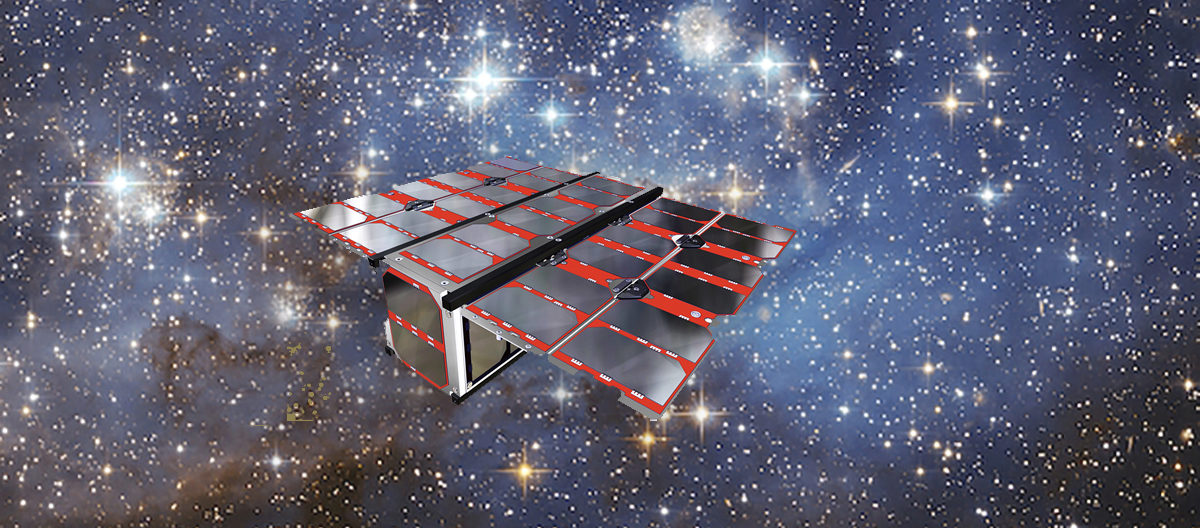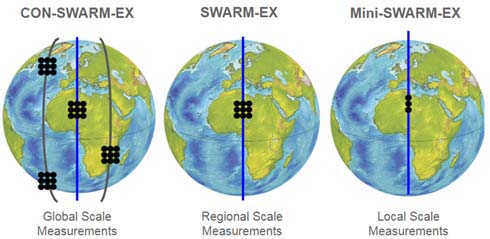 |
| SWARM-EX Rising. An illustration of one of the three CubeSats that will be designed and deployed as a part of the Space Weather Atmospheric Reconfigurable Multiscale Experiment (SWARM-EX) initiative, funded by the National Science Foundation. |
 |
| Prof. E. Glenn Lightsey |
If CubeSat technology has cracked open the door to next generation space science, CubeSat swarms promise to bust that door off its hinges.
Prof. E. Glenn Lightsey is already pushing through that opening.
"CubeSat technology has been transformative over the last few years. It's light-weight, it's cost-effective, and it's flexible. We can now create constellations of CubeSats - equipped with specialized instruments - and deploy them, together, to study different aspects of our solar system and our own atmosphere," says Lightsey, who heads up AE's Space Systems Design Lab and Georgia Tech's Center for Space Technology and Research (C-STAR).
"The science, and the questions we're trying to answer, haven't changed, but, with more and better satellite technology to accomplish the job, we are able to do more with less."
Lightsey and colleagues from the University of Colorado-Boulder are exploiting this opportunity by launching their work on SWARM-EX, a four-year National Science Foundation-funded project that will both demonstrate new CubeSat technology and address some unanswered questions about the Earth's atmosphere.
 |
| Conceptual implementation of the SWARM-EX concept. A constellation of SWARM-EX swarms (left) in different orbits, a SWARM-EX swarm in a single orbit (middle) and SWARM-EX demonstration mission with 3 CubeSats in a common orbit (right). |
"The Earth's atmosphere at higher altitudes is a bit of a physics laboratory, something we don't entirely understand," explains Lightsey.
"We have all of this energy coming into our atmosphere, but we don't know where all of it goes. The sun delivers 1366 watts per square meter of energy, which is really a lot. And there's the Earth's magnetic field, the radioactive decay at the Earth's core, and the chemical energy that humans are releasing into the atmosphere. We know this energy drives our air temperature and our weather. It heats up the oceans, and contributes to global warming. But we can't account for it all. We know some of it goes into the ionosphere, but, really, there's a lot more we don't know."
That's where the Space Weather Atmospheric Reconfigurable Multiscale Experiment (SWARM-EX) comes in.
SWARM-EX is intended to help scientists make multiple in-situ ionospheric and thermospheric measurements. It is a pathfinder mission, so-called because demonstrates on a small-scale, technologies that will ultimately be deployed in greater numbers. Loaded onto the initial three-sat SWARM-EX formation will be key technologies - a neutral oxygen sensor and a Langmuir Probe, for instance - that will help scientists tackle poorly understood phenomena like the evolution of the equatorial ionization anomaly (EIA) and equatorial thermospheric anomaly (ETA).
Once proven, the concept can be expanded to deploy a swarm of six to 12 CubeSats, each with an elaborate suite of instruments.
“This technology will let us study the Earth’s upper atmosphere from within it – not above or below it- so we can observe more about what's going on,” Lightsey says.
“The great thing about SWARM-EX is that, with three CubeSats, we'll be able to study atmospheric phenomena from different angles and at different distances - from one kilometer to 1000 kilometers -- depending on what we're trying to study. We'll have equipment that will allow us to measure the speed of electrons and constituency of various particles - their velocity, mass, density and charge - so we can reconstruct what's going on in the upper atmosphere.”
One of those phenomena is a plasma bubble - a condition that results when solar energy causes neutral molecules to lose their electrons. This causes pockets of ionized gases -or plasma - to form.
"These bubbles don't develop all at once or uniformly. It's more like the way water boils - in pockets of bubbles. With SWARM-EX we can study these time and spatially separated events, because we're not limited to one angle or one distance."
The SWARM-EX mission is one of two that Lightsey helped form during the NSF's Ideas Lab Workshop, held in February of 2019. As one of the 40 scientists, engineers, and technologists invited to attend, Lightsey brainstormed ideas for advancing the use of CubeSat Formation Flying in the NSF's mission. The week-long incubator concluded with a Shark Tank-like competition, in which teams of participants vied to have one of their proposals funded by the NSF. Lightsey was on the teams that proposed two winning proposals - for SWARM-EX and for VISORS, a mission that will explore solar coronal heating.
"I thought both of these projects were very strong, so, while I certainly didn't expect to have both selected, I was very happy to see that they were," he said. "These missions will advance the NSF's mission to understand the physical connection between our sun and the Earth."